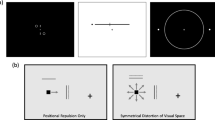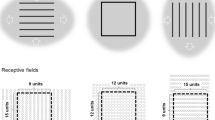Abstract
The effects of left and right alignment on the Ebbinghaus illusion were investigated in three experiments. In Experiment 1, the Ebbinghaus illusion was presented on the left or right side, and the points of subjective equality (PSE) were measured. Only the central disk of the figure with small inducers was perceived larger when it was positioned on the right side rather than on the left. In Experiments 2 and 3, left, right, and central placement were used to determine if the results of Experiment 1 were caused by a decrease of the illusion on the left side or an increase of the illusion on the right side. There was no difference in the illusion effect between the left and the center; however, the illusion effect increased when the figure was presented on the right side. These results suggest that a hemispheric asymmetry for global and local spatial attention influences the laterality of the Ebbinghaus illusion.







Similar content being viewed by others
Notes
In Experiments 2 and 3, a No-inducer single disk condition was not included. Thus, the magnitude of illusion was calculated with the actual size of the disk in these experiments. There was no difference between the results that were calculated with an actual size and those that were calculated with the perceived size of a No-inducer single disk in Experiment 1. Furthermore, there were no significant differences between the actual size and perceived size of the No-inducer single target disk. Because the apparatus (PC and monitor) did not change in these three experiments, the magnitude of illusion of Experiments 2 and 3 was calculated with the actual size of the disk.
References
Bertelson P, Morais J (1983) A Ponzo-like illusion left and right of fixation: a failed prediction. Neuropsychol 21(1):105–109. https://doi.org/10.1016/0028-3932(83)90105-7
Brainard DH (1997) The psychophysics toolbox. Spat Vis 10(4):433–436. https://doi.org/10.1163/156856897X00357
Clem RK, Pollack RH (1975) Illusion magnitude as a function of visual field exposure. Percept Psychophys 17(5):450–454. https://doi.org/10.3758/BF03203292
Coren S, Enns JT (1993) Size contrast as a function of conceptual similarity between test and inducers. Percept Psychophys 54(5):579–588. https://doi.org/10.3758/BF03211782
Dickinson CA, Intraub H (2009) Spatial asymmetries in viewing and remembering scenes: consequences of an attentional bias? Atten Percept Psychophys 71(6):1251–1262. https://doi.org/10.3758/APP.71.6.1251
Doherty MJ, Campbell NM, Tsuji H, Phillips WA (2010) The Ebbinghaus illusion deceives adults but not young children. Dev Sci 13(5):714–721. https://doi.org/10.1111/j.1467-7687.2009.00931.x
Gonzalez CL, Ganel T, Goodale MA (2006) Hemispheric specialization for the visual control of action is independent of handedness. J Neurophysiol 95(6):3496–3501. https://doi.org/10.1152/jn.01187.2005
Grabowska A, Szymanska O, Nowicka A, Kwiecien M (1992) The effect of unilateral brain lesions on perception of visual illusions. Behav Brain Res 47(2):191–197. https://doi.org/10.1016/S0166-4328(05)80125-1
Greist SM, Grier JB (1977) The effect of retinal location on the magnitude of the Poggendorff illusion. Percept Psychophys 21(3):249–252. https://doi.org/10.3758/BF03214235
Hatada T (1993) Measurement of information receiving and visual field. Jap J Ergonom 29:86–88. https://doi.org/10.5100/jje.29.Supplement_86 (in Japanese)
Hellige JB, Laeng B, Michimata C (2010) Processing asymmetries in the visual system. In: Hugdahl R, Westerhausen K (eds) The two halves of the brain: information processing in the cerebral hemispheres. MIT Press, Cambridge, MA, pp 379–415. https://doi.org/10.7551/mitpress/9780262014137.003.0279
Jaeger T (1978) Ebbinghaus illusions: size contrast or contour interaction phenomena? Percept Psychophys 24(4):337–342. https://doi.org/10.3758/BF03204250
Jaeger T, Klahs K (2015) The Ebbinghaus illusion: New contextual effect and theoretical considerations. Percept Mot Skills 120(1):177–182. https://doi.org/10.2466/24.27.PMS.120v13x4
Jewell G, McCourt ME (2000) Pseudoneglect: a review and meta-analysis of performance factors in line bisection tasks. Neuropsychol 38(1):93–110. https://doi.org/10.1016/S0028-3932(99)00045-7
Josev EK, Forte JD, Nicholls ME (2011) Left of centre: asymmetries for the horizontal vertical line illusion. Psychol Res 75(5):435–443. https://doi.org/10.1007/s00426-010-0315-2
Kingdom F, Prins N (2016) Psychophysics: a practical introduction. Academic Press, Cambridge, MA
Martinez A, Moses P, Frank L, Buxton R, Wong E, Stiles J (1997) Hemispheric asymmetries in global and local processing: evidence from fMRI. NeuroReport 8(7):1685–1689. https://doi.org/10.1097/00001756-199705060-00025
Massaro D, Anderson N (1971) Judgmental model of the Ebbinghaus illusion. J Exp Psychol 89(1):147–151. https://doi.org/10.1037/h0031158
Mattingley JB, Bradshaw JL, Nettleton NC, Bradshaw JA (1994) Can task specific perceptual bias be distinguished from unilateral neglect? Neuropsychol 32:806–817. https://doi.org/10.1016/0028-3932(94)90019-1
Moses P, Roe K, Buxton RB, Wong EC, Frank LR, Stiles J (2002) Functional MRI of global and local processing in children. Neuroimage 16(2):415–424. https://doi.org/10.1006/nimg.2002.1064
Nicholls MER, Roberts GR (2002) Can free-viewing perceptual asymmetries be explained by scanning, pre-motor or attentional biases? Cortex 38(2):113–136. https://doi.org/10.1016/S0010-9452(08)70645-2
Nicholls MER, Bradshaw JL, Mattingley JB (1999) Free-viewing perceptual asymmetries for the judgement of brightness, numerosity and size. Neuropsychol 37(3):307–314. https://doi.org/10.1016/S0028-3932(98)00074-8
Rasmjou S, Hausmann M, Güntürkün O (1999) Hemispheric dominance and gender in the perception of an illusion. Neuropsychol 37(9):1041–1047. https://doi.org/10.1016/S0028-3932(98)00154-7
Roe K, Moses P, Stiles J (1999) Lateralization of spatial processes in school aged children. Cogn Neurosci Soc
Rothwell B, Zaidel E (1990) Visual field differences in the magnitude of the Oppel–Kundt illusion vary with processing time. Percept Psychophys 47(2):180–190. https://doi.org/10.3758/BF03205982
Shulman GL (1992) Attentional modulation of size contrast. Quart J Exp Psychol 45(4):529–546. https://doi.org/10.1080/14640749208401332
Taylor MM, Creelman DC (1967) PEST: efficient estimates on probability functions. J Acoust Soc Am 41(4):782–787. https://doi.org/10.1121/1.1910407
Van Kleeck MH (1989) Hemispheric differences in global versus local processing of hierarchical visual stimuli by normal subjects: new data and a meta-analysis of previous studies. Neuropsychol 27(9):1165–1178. https://doi.org/10.1016/0028-3932(89)90099-7
Voyer D, Voyer SD, Tramonte L (2012) Free-viewing laterality tasks: a multilevel meta-analysis. Neuropsychol 26(5):551–567. https://doi.org/10.1037/a0028631
Acknowledgements
This study was supported by a JSPS KAKENHI Grant (number 25780445) to AS. I would like to thank the editor and three referees who have devoted time to reading and commenting on this paper. Furthermore, I would like to thank C. Michimata, B. Laeng, and M. Okubo for their helpful comments on this study. I am also grateful to R. Hosoya, K. Mothohashi, and K. Seko for their help with the experiments. I thank CDS group for their support for writing the paper.
Author information
Authors and Affiliations
Corresponding author
Ethics declarations
Conflict of interest
The author declares that there is no conflict of interest.
Ethical approval
All procedures performed in studies involving human participants were in accordance with the ethical standards of the institutional and/or national research committee and with the 1964 Helsinki declaration and its later amendments or comparable ethical standards. All experimental procedures were approved by the Institutional Review Board of the Teikyo University Psychology Department (no. 227).
Informed consent
Informed consent was obtained from all individual participants included in the study.
Rights and permissions
About this article
Cite this article
Saneyoshi, A. The Ebbinghaus illusion with small inducers appears larger on the right side. Exp Brain Res 236, 933–944 (2018). https://doi.org/10.1007/s00221-018-5168-8
Received:
Accepted:
Published:
Issue Date:
DOI: https://doi.org/10.1007/s00221-018-5168-8




